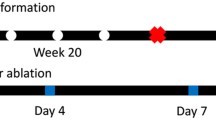Abstract
Background
Although often proposed as a means to reduce the harmful consequences of tumor spill, water lavage has yet to be systematically evaluated in relevant in vitro and in vivo models. This study evaluates the mechanisms and utility of a single water lavage to improve the sequelae of tumor spill during laparotomy.
Methods
Murine colorectal tumor cell susceptibility to water-induced osmotic lysis was characterized in vitro. A reproducible model of tumor spill was established to recapitulate water or saline lavage during laparotomy. Analyses of tumor volumes calculated from noninvasive imaging were performed. The tumor volumes and survival of mice treated with water, normal saline, or sham laparotomy were assessed.
Results
Significant osmotic lysis of cultured murine colorectal cancer cells was observed after a brief exposure to water. Compared to saline or sham laparotomy, water lavage demonstrated superior clinical outcomes with a decrease in tumor burden and concomitant improvement in survival.
Conclusions
The use of water lavage during oncologic surgeries to reduce the sequelae of tumor spill is justified and strongly supported by our study. Data from our study raise several concerns regarding the mechanisms and efficacy of saline lavage. Clinically, the use of water lavage during laparotomy would be anticipated to reduce peritoneal disease burden with minimal toxicity or cost.





Similar content being viewed by others
References
BookRags Biographies. http://www.bookrags.com/biography/anton-van-leeuwenhoek/.
Lin CH, Hsieh HF, Yu JC, et al. Peritoneal lavage with distilled water during liver resection in patients with spontaneously ruptured hepatocellular carcinomas. J Surg Oncol. 2006;94:255–6.
Whiteside OJ, Tytherleigh MG, Thrush S, et al. Intra-operative peritoneal lavage—who does it and why? Ann R Coll Surg Engl. 2005;87:255–8.
Huguet EL, Keeling NJ. Distilled water peritoneal lavage after colorectal cancer surgery. Dis Colon Rectum. 2004;47:2114–9.
Morris PC, Scholten V. Osmotic lysis of tumor spill in ovarian cancer: a murine model. Am J Obstet Gynecol. 1996;175:1489–92.
Koppe MJ, Boerman OC, Oyen WJ, Bleichrodt RP. Peritoneal carcinomatosis of colorectal origin: incidence and current treatment strategies. Ann Surg. 2006;243:212–22.
Guller U, Zajac P, Schnider A, et al. Disseminated single tumor cells as detected by real-time quantitative polymerase chain reaction represent a prognostic factor in patients undergoing surgery for colorectal cancer. Ann Surg. 2002;236:768–75.
Oosterling SJ, van der Bij GJ, van Egmond M, van der Sijp JR. Surgical trauma and peritoneal recurrence of colorectal carcinoma. Eur J Surg Oncol. 2005;31:29–37.
Raa ST, Oosterling SJ, van der Kaaij NP, et al. Surgery promotes implantation of disseminated tumor cells, but does not increase growth of tumor cell clusters. J Surg Oncol. 2005;92:124–9.
Yamamoto S, Akasu T, Fujita S, Moriya Y. Long-term prognostic value of conventional peritoneal cytology after curative resection for colorectal carcinoma. Jpn J Clin Oncol. 2003;33:33–7.
Kanellos I, Demetriades H, Zintzaras E, et al. Incidence and prognostic value of positive peritoneal cytology in colorectal cancer. Dis Colon Rectum. 2003;46:535–9.
Wind P, Norklinger B, Roger V, et al. Long-term prognostic value of positive peritoneal washing in colon cancer. Scand J Gastroenterol. 1999;34:606–10.
Jayne DG, Fook S, Loi C, Seow-Choen F. Peritoneal carcinomatosis from colorectal cancer. Br J Surg. 2002;89:1545–50.
Altekruse SF, Kosary CL, Krapcho M, Neyman N, et al (eds). SEER cancer statistics review, 1975–2007. Bethesda, MD: National Cancer Institute; 2010.
Park KG, Chetty U, Scott W, Miller W. The activity of locally applied cytotoxics to breast cancer cells in vitro. Ann R Coll Surg Engl. 1991;73:96–9.
Pattana-arun J, Wolff BG. Benefits of povidone-iodine solution in colorectal operations: science or legend. Dis Colon Rectum. 2008;51:966–71.
Basha G, Ghirardi M, Geboes K, et al. Limitations of peritoneal lavage with antiseptics in prevention of recurrent colorectal cancer caused by tumor-cell seeding: experimental study in rats. Dis Colon Rectum. 2000;43:1713–8.
Basha G, Penninckx F, Yap P. Influence of blood components and faeces on the in vitro cancericidal activity of povidone-iodine. Br J Surg. 1998;85:534–7.
Stuntz M, Wilmoth G, Ong J, et al. Use of intraperitoneal 5-fluorouracil and chlorhexidine for prevention of recurrence of perforated colorectal carcinoma in a rat model. Dis Colon Rectum. 1997;40:1085–8.
Brundell S, Tucker K, Chatterton B, Hewett P. Influence of lavage timing on tumor cell burden during colonic resection. Dis Colon Rectum. 2003;46:460–6.
Brundell SM, Tucker K, Chatterton B, Hewett PJ. The effect of lavage on intraabdominal cell burden. Surg Endosc. 2002;16:1064–7.
Fermor B, Umpleby HC, Lever JV, et al. Proliferative and metastatic potential of exfoliated colorectal cancer cells. J Natl Cancer Inst. 1986;76:347–9.
van der Bij GJ, Oosterling SJ, Beelen RH, et al. The perioperative period is an underutilized window of therapeutic opportunity in patients with colorectal cancer. Ann Surg. 2009;249:727–34.
Acknowledgment
The authors would like to thank Ree Dolnick, Daniel Fisher, and Jason Muhitch for their outstanding technical assistance. Supported by the U.S. National Institutes of Health (CA16056 to Roswell Park Cancer Institute).
Conflict of interest
The authors report no commercial interests or conflicts of interest regarding the contents of this manuscript.
Author information
Authors and Affiliations
Corresponding author
Rights and permissions
About this article
Cite this article
Ito, F., Camoriano, M., Seshadri, M. et al. Water: A Simple Solution for Tumor Spillage. Ann Surg Oncol 18, 2357–2363 (2011). https://doi.org/10.1245/s10434-011-1588-4
Received:
Published:
Issue Date:
DOI: https://doi.org/10.1245/s10434-011-1588-4




